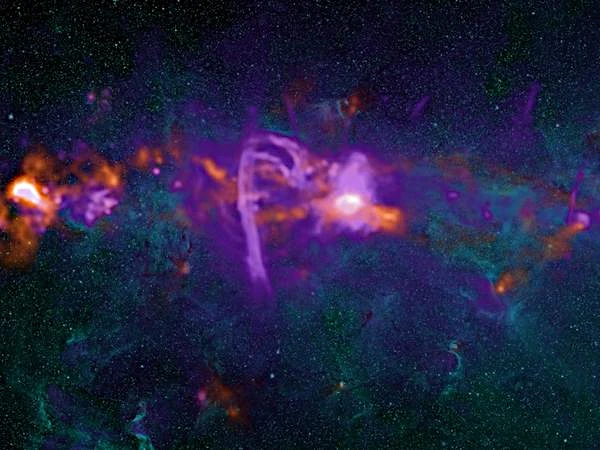
Sagittarius A* (Sgr A*) is the supermassive black hole located at the center of the Milky Way, in the constellation Sagittarius. Its mass is estimated at about 4.1 × 106 solar masses, and its Schwarzschild radius is approximately 17.2 million kilometers. This black hole gravitationally dominates the movements of stars and surrounding gas within a radius of several parsecs, forming what is known as the galactic bulge.
Sgr A* is surrounded by a dense region of stars, known as the stellar core of the galactic bulge, and an accretion disk composed of hot gas and dust. Gravitational and magnetic interactions in this area produce intense electromagnetic emissions in radio, infrared, and X-ray bands. This system represents a unique natural laboratory for testing the predictions of general relativity under extreme conditions and for studying accretion processes and gravitational relativity around a supermassive black hole.
The properties of Sgr A* have been primarily studied by tracking the orbits of stars near the galactic center, observed in infrared using adaptive optics techniques and in radio via Very Long Baseline Interferometry (VLBI). Instruments such as the ESO's Very Large Telescope (VLT) and the Keck Observatory have enabled the measurement of the position and velocity of these stars with milliarcsecond precision, allowing the mass and location of Sgr A* to be deduced with high reliability.
Radio and submillimeter observations have revealed a very compact accretion disk, where gas and dust heated by gravity emit variable radiation and sporadic flares. These flares are likely linked to magnetic reconnections and plasma instability near the event horizon. X-ray emissions detected by the Chandra and XMM-Newton satellites have allowed the variability of radiation to be tracked on timescales from a few minutes to several hours, providing additional constraints on the dynamics and density of the gas surrounding Sgr A*.
Additional observations using infrared spectroscopy techniques have measured the chemical composition and temperature distribution of the gas and stars around the black hole, providing valuable clues about the history of accretion and star formation in the galactic bulge.
| Property | Value / Observation | Method | Comment |
|---|---|---|---|
| Mass | 4.1 × 106 M☉ | Monitoring orbits of nearby stars | Precise measurement of central mass from stellar gravity |
| Distance from Sun | ≈ 8.2 kpc (26,700 light-years) | Parallax and stellar orbits | Locates the galactic center within the Milky Way |
| Schwarzschild radius | ≈ 17.2 million km | Theoretical calculation from mass | Defines the scale of the event horizon |
| Spin (angular momentum) | Moderate to high estimate | Analysis of X-ray emissions and accretion disk | Influences disk dynamics and nearby stars |
| Radio and X-ray emissions | Rapid variability and sporadic flares | VLBI, VLA, Chandra, and XMM-Newton observations | Indicates accretion disk activity and plasma–magnetic field interactions |
| Variability type | Sporadic, quasi-periodic flares | X-ray and IR photometry | Linked to plasma instability near the event horizon |
| Velocity of nearby stars | Up to 10,000 km/s | Tracking stellar orbits in infrared | Constrains mass and gravitational distribution |
| Accretion disk | Compact, hot, and variable | Radio/submillimeter observations, IR spectroscopy | Source of variable radiation and plasma heating |
| Gas composition | Hydrogen, helium, traces of metals | Infrared spectroscopy | Indicates gas origin and chemical processes in the galactic center |
| Gas temperature | 1–10 million K in inner disk | X-ray and IR spectroscopy | High-temperature plasma near the event horizon |
| Jets or relativistic winds | No powerful jets observed; weak winds possible | Radio and submillimeter observations | Absence of strong jets, presence of weak winds |
Sources: ESO – Observations of the galactic center, Ghez et al., 2008.
Studying Sagittarius A* allows testing the predictions of Albert Einstein's general relativity (1915) in an extreme gravitational environment. The orbits of nearby stars, the precession of their trajectories, and the variability of radio and X-ray emissions provide direct constraints on the spacetime metric around a supermassive black hole.
Observing Sgr A* offers a unique opportunity to understand accretion processes and angular momentum transfer, the formation of accretion disks, and the behavior of relativistic plasma near the event horizon. It also allows studying the limits of theoretical models on the mass and spin of black holes, as well as their interaction with the stellar and interstellar environment.
Sgr A* influences the dynamics of the galactic bulge and star formation in the immediate vicinity. Its gravity shapes the orbits of stars and regulates gas accretion, providing clues about the overall evolution of the Milky Way. These studies also contribute to a better understanding of the mechanisms of co-evolution of galaxies and their central black holes.
By comparing observations of Sgr A* with those of supermassive black holes in other active galaxies, scientists can distinguish universal characteristics of accretion disks, jets, and electromagnetic variability, and identify particularities related to the mass and environment of each black hole.